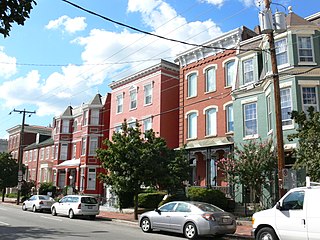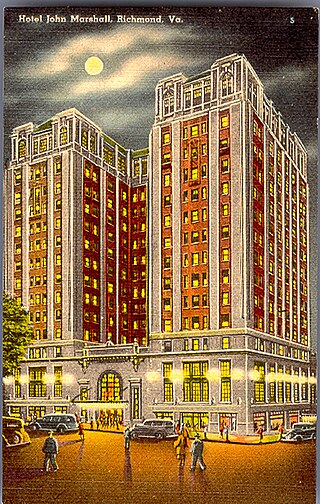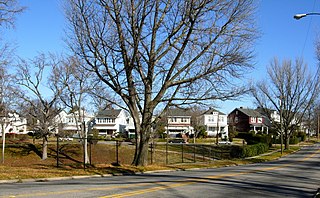
The Batesville Historic District is a national historic district located at Batesville, Albemarle County, Virginia. In 1999, when it was listed on the National Register of Historic Places, it included 33 buildings deemed to contribute to the historic character of the area. They include representative examples of the early-19th century Federal Style, the mid-19th century Greek Revival Style, simple late-Victorian styles from the late-19th century- and early-20th century, Classical Revival and Colonial Revival styles. Notable buildings include the Batesville Elementary School (1922), Batesville Public School, Mount Ed Baptist Church, Batesville Methodist Church (1861), Dr. Smith House, the Barskdale House, Hill House, and Page's Store.

Highland Park Public School is a historic school building located in Richmond, Virginia. The structure was built in 1909 based on a design by noted Virginia architect Charles M. Robinson. The Mediterranean Revival building is a two-story brick and stucco structure topped by hipped roofs clad with terra cotta tiles. In its use of the Mediterranean Revival style, the building was a departure from the Georgian and Gothic styles commonly used in Virginia school buildings of the time. The building used as the community school for Highland Park, Virginia, until the community was annexed by the City of Richmond in 1914. It served thereafter as a neighborhood school in the Richmond public school system until it closed in the 1970s. The building is considered to be important as an example of the work of Charles M. Robinson, who served as Richmond School Board architect from 1909 to 1930. The building was listed on the National Register of Historic Places in 1991. The building was converted from 1990 to 1991 into a residential apartment complex for senior citizens and re-opened under the name Brookland Park Plaza.

The Oakwood–Chimborazo Historic District is a national historic district of 434 acres (176 ha) located in Richmond, Virginia. It includes 1,284 contributing buildings, three contributing structures, five contributing objects and four contributing sites. It includes work by architect D. Wiley Anderson. The predominantly residential area contains a significant collection of late-19th and early-20th century, brick and frame dwellings that display an eclectic mixture of Late Victorian, Queen Anne, and Colonial Revival styles.

Clifton Forge Commercial Historic District is a national historic district located at Clifton Forge, Alleghany County, Virginia. The district encompasses 77 contributing buildings in the central business district of Clifton Forge. It primarily includes frame, brick, and concrete block commercial buildings dating to the late-19th and early-20th centuries. The buildings are in a variety of popular architectural styles including Classical Revival, Mission/Spanish Revival, and Italianate. Notable buildings include the Hawkins Brothers Store, Wiley House (1891), Chesapeake and Ohio Office Building (1906), Masonic Theatre (1905), Alleghany Building (1905), Clifton Forge City Hall (1910-1911), U.S. Post Office (1910), Ridge Theatre (1929), the Farrar Building (1930), and the Pure Oil Company Service Station (1932).

Highland Park–Overlee Knolls, also known as Fostoria, is a national historic district located in Arlington County, Virginia. It is directly east of the Virginia Heights Historic District. It contains 681 contributing buildings, 3 contributing sites, and 1 contributing structure in a residential neighborhood in North Arlington. The first subdivision was platted in 1890 and known as Fostoria.

Covington Historic District is a national historic district located at Covington, Virginia. The district encompasses 108 contributing buildings, 1 contributing site, and 1 contributing structure in the historic core of the city of Covington. It includes late-19th and early-20th-century commercial buildings, dwellings that date from around 1820 until 1940, and governmental, educational, religious, industrial, and transportation-related buildings. Notable buildings include Merry Stand, the James Burk House (1824), Callaghan House (1840s), William W. Lawrence House (1850s), Rinehart Building, Covington Savings Bank (1910s), I. O. O. F. Building, Covington Post Office (1914), Hotel Collins (1910), Hippodrome Theater (1920s), C&O Railway and Freight Station (1914-1915), Alleghany County Courthouse (1910), Alleghany County Jail, Sacred Heart Catholic Church, Emmanuel Episcopal Church, First Presbyterian Church (1924), and Covington Baptist Church (1902).

Poplar Lawn Historic District is a national historic district located at Petersburg, Virginia. The district is named after Petersburg's central park which was often a military parade ground in the early 19th century, but became a tent-based detention center and hospital during the American Civil war and later became the site of civic celebrations, including possibly the first Memorial Day, on June 9, 1865. The district also includes 372 contributing buildings, mostly mid- to late-19th-century, single-family residences for middle and upper-middle-class families, some constructed of brick, others weatherboard frame, and later subdivided. Residential architectural styles include Greek Revival, Colonial Revival, Second Empire, and Italianate. Notable buildings include the Bolling-Zimmer House, St. Stephen's Church, Zion Baptist Church, William T. Double House, the Waterworks (1856), Dr. Robert Broadnax House (1858), Market Street Methodist Church Parsonage, Maurice Finn House, and the Frank M. D'Alton Double House.

North Battersea-Pride's Field Historic District is a national historic district located at Petersburg, Virginia. The district includes 156 contributing buildings and 2 contributing sites located in a predominantly residential section of Petersburg. It includes a varied collection of mid- to late 19th- and early 20th-century middle and working-class houses and includes notable examples of Queen Anne and Gothic Revival style architecture. Notable buildings include the late-18th century stone toll keeper's house, Montview, Pride's Tavern dependency, and West Street Presbyterian Chapel.

The West Franklin Street Historic District is a national historic district located at Richmond, Virginia. It is located along the northern boundary of the Fan district. The district encompasses 71 contributing buildings built between about 1870 and the 1920. It was originally developed as a primarily residential district with buildings in a variety of popular late-19th and early-20th century architectural styles including Greek Revival, Romanesque, Georgian Revival, Queen Anne, and Italianate. Many of the dwellings have been converted to commercial use. In addition, the district's private houses have been converted into multi-family housing and departmental offices for Virginia Commonwealth University. Notable buildings include Franklin Terrace, the Ritter-Hickock House, First Independent Church, Founder's Hall, the Raleigh Building, The Greyston Apartments, Gresham Court Apartments, and the Beth Ahabah Congregation Hall and Synagogue.

The Two Hundred Block West Franklin Street Historic District is a national historic district located at Richmond, Virginia. It is located between downtown and the Fan district. The district encompasses 13 contributing buildings built during the 19th century and in a variety of popular architectural styles including Greek Revival, Federal, Beaux-Arts, and Queen Anne. Many of the dwellings have been converted to commercial use. Notable buildings include Queen Anne Row (1891), the Carter-Mayo House designed by Carrère and Hastings, the Cole Diggs House, the Smith-Palmer House, the Ida Schoolcraft House, the Price House, the A. S. Smith House, and the T. Seddon Bruce House.

The Block 0-100 East Franklin Street Historic District is a national historic district located at Richmond, Virginia. It is located west of downtown. The district encompasses 21 contributing buildings built between about 1840 and 1920. The district is characterized by numerous mid- to late-19th century brick town houses in a variety of popular 19th-century architectural styles including Queen Anne, Italianate, and Greek Revival.

The Grace Street Commercial Historic District is a national historic district located in Richmond, Virginia. The district encompasses 93 contributing buildings located in downtown Richmond. The buildings reflect the core of the city's early 20th-century retail development and the remnants of a 19th-century residential neighborhood. The buildings are in a variety of popular 19th-century and early 20th-century architectural styles, including Classical Revival, Mission Revival, International Style, and Colonial Revival. Notable buildings include the Administration and Equipment Building for the Chesapeake & Potomac Telephone Company (1929), Thalhimer's Department Store, Atlantic Life Building (1950-1959), Miller & Rhoads Department Store, Berry-Burk Building, former W. W. Foster Studios (1927), Bank of Virginia (1949), Investment Realty Company building (1930), W.T. Grant Store (1939), Hotel John Marshall (1927), Franklin Federal Savings and Loan building (1954), and the Tompkins House (1820). Located in the district and separately listed are the Loew's Theatre, Centenary United Methodist Church, Joseph P. Winston House, Central National Bank, and National Theater.

The Carver Residential Historic District is a national historic district located at Carver, Richmond, Virginia. The district encompasses 312 contributing buildings and 1 contributing site located west of downtown Richmond. The primarily residential area developed starting in the mid-19th century. The buildings are in a variety of popular 19th-century and early 20th-century architectural styles, including Gothic Revival and Greek Revival. Notable buildings include the Hardin Davis House (1842), Amanda Ragland House (1843), Reuben Lacy House (1859), Rueben T. Hill House (1900), George Washington Carver Elementary School (1887), Moore Street Baptist Church (1909), Baughman Brothers/Biggs Antique Company building (1924), and the T&E Laundry Company Building.

The Laburnum Park Historic District is a national historic district located at Richmond, Virginia. The district encompasses 226 contributing buildings and 2 contributing structures located north of downtown Richmond. The primarily residential area developed starting in the early-20th century as one of the city's early "streetcar suburbs" and as home to several important local institutions. The buildings are in a variety of popular early-20th century architectural styles including Queen Anne and Colonial Revival. It was developed as neighborhood of middle-to-upper-class, single-family dwellings. Notable buildings include the Laburnum House (1908), Richmond Memorial Hospital (1954-1957), Richmond Memorial Hospital Nursing School (1960-1961), "The Hermitage" (1911), Laburnum Court (1919), Veritas School.

The Brookland Park Historic District is a national historic district located at Richmond, Virginia. The district encompasses 1,157 contributing buildings located north of downtown Richmond and Barton Heights.

The Battery Court Historic District is a national historic district located at Richmond, Virginia. The district encompasses 549 contributing buildings and 1 contributing site located north of downtown Richmond and west of Barton Heights and Brookland Park. The primarily residential area developed starting in the early-20th century as one of the city's early “streetcar suburbs.” The buildings are in a variety of popular late-19th and early-20th century architectural styles including frame bungalows, American Foursquare, Colonial Revival, Tudor Revival, and Mission Revival. Notable non-residential buildings include the Overbrook Presbyterian Church and Battery Park Christian Church.

The Three Chopt Road Historic District is a national historic district located at Richmond, Virginia. The district encompasses 90 contributing buildings, 4 contributing sites, and 4 contributing structures located west of downtown Richmond. The primarily residential area developed starting in the early-20th century as one of the city's early "streetcar suburbs." The buildings are in a variety of popular late-19th and early-20th century architectural styles including frame bungalows, Colonial Revival, Tudor Revival, and Mission Revival. There are a remarkable group of unusually large, architect-designed houses and churches. Notable non-residential buildings include St. Bridget's Catholic Church (1950) and St. Stephen's Episcopal Church. Located in the district is the separately listed Green's Farm (Huntley).

The Forest Hill Historic District is a national historic district located at Richmond, Virginia. The district encompasses 1,106 contributing buildings and 5 contributing structures located south of downtown Richmond. The primarily residential area developed starting in the early-20th century as one of the city's early "streetcar suburbs." The buildings are in a variety of popular late-19th and early-20th century architectural styles including frame bungalows, Colonial Revival, Tudor Revival, and Mission Revival. The buildings in Forest Hill exemplify a high quality of materials in their construction. Brick is the dominant building material. Notable non-residential buildings include Forest Hill Presbyterian Church; Good Shepherd Episcopal Church; and Forest Hill Church of Christ.

Wharf Area Historic District is a national historic district located at Staunton, Virginia. The district encompasses 22 contributing buildings and 4 contributing structures. It is a warehouse and commercial district characterized by rows of late-19th century and early-20th century storefronts and an elongated plaza framed by small warehouses. The buildings are characteristically two- and three-story, brick structures in a variety of popular architectural styles including Greek Revival, Federal, and Queen Anne. Notable buildings and structures include the Railroad Water Tower, American Hotel, John Burns Building (1874), Erskine Building (1904), and Chesapeake and Ohio Railroad Station (1902).

Stuart Addition Historic District is a national historic district located at Staunton, Virginia. The district encompasses 93 contributing buildings in a primarily residential section of Staunton. The district includes some early 19th-century structures, but most of the homes were built after 1870. The medium-density residential area includes notable examples of the Colonial Revival, Italianate, and Gothic Revival styles. Notable buildings include the Blakely or Templeton House, Steele House (1928), Kivlighan House (1910), Arlington Flats, D. Webster Davis School (1915), St. Francis of Assisi Catholic Church (1895), Augusta Street Methodist Church, Ebenezer Baptist Church (1910), and Mt. Zion Baptist Church (1904). Located in the district is the separately listed C. W. Miller House.
























